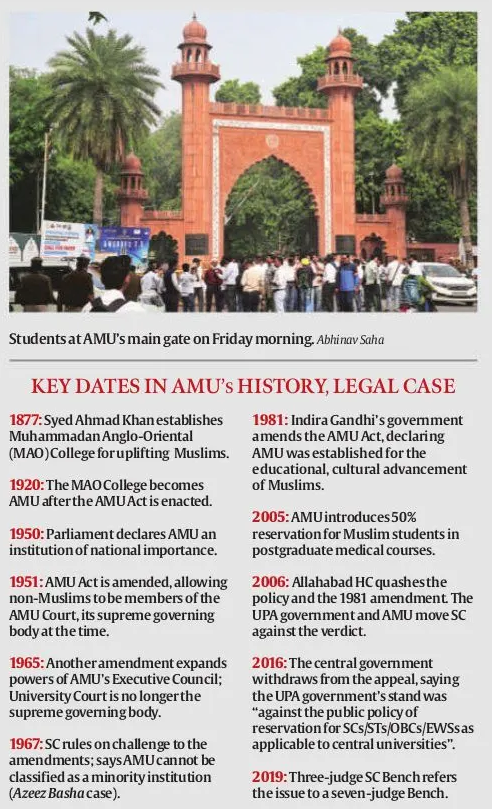Table of Contents
Background of the Aligarh Muslim University (AMU) Minority Status
- The controversy began in 1967 when the Supreme Court ruled that amendments to AMU’s founding Act stripped the Muslim community of its right to administer the university.
- 1951: Non-Muslims were permitted to join AMU’s highest governing body, the University Court. Additionally, the role of “Visitor” (formerly held by the Lord Rector) was assigned to the President of India.
- 1965: Powers were shifted from the University Court to the Executive Council, reducing the former’s control over the institution.
- In the Azeez Basha vs. Union of India case (1967), the Supreme Court held that AMU was not established by the Muslim community but by an Act of Parliament—the Aligarh Muslim University Act, 1920—and thus could not claim minority status.
- To address the Supreme Court’s judgment, the government amended the AMU Act in 1981, declaring that AMU was founded by the Muslim community to promote its cultural and educational objectives.
- The Allahabad High Court struck down the 1981 amendment and cancelled AMU’s 50% reservation for Muslim students, reaffirming the Supreme Court’s Azeez Basha ruling.

Protections for MEIs
- Article 30(1) grants all minorities, whether defined by religion or language, the right to establish and manage educational institutions of their choice.
- Article 30(1A) addresses the determination of compensation when acquiring property from any educational institution set up by minorities.
- Article 30(2) states that the government should not discriminate against any educational institution managed by a minority when providing aid.
Criteria laid by the Supreme Court For AMU’s minority status
- Requirement for Minority Status: To qualify under Article 30(1), an educational institution must be established by a minority community.
- This involves determining who originally founded the institution and if it was primarily meant to serve that community.
- Holistic Two-Fold Test:
- First Limb: Identify the originators, or the “brain behind” the institution, by examining documents and communications that reveal the founders’ intentions.
- Second Limb: Evaluate if the institution’s administrative structure maintains its minority character, ensuring it continues to protect and advance the interests of the minority community.
- Broad Definition of “Established”: The term “established” is interpreted broadly, meaning an institution can still retain minority status even if governed by a statutory body or if its legal standing has evolved over time.


 Places in News for UPSC 2025 for Prelims...
Places in News for UPSC 2025 for Prelims...
 New Phase of Operation Chakra to Combat ...
New Phase of Operation Chakra to Combat ...
 Soyuz Aircraft: History, Design and Sign...
Soyuz Aircraft: History, Design and Sign...





















